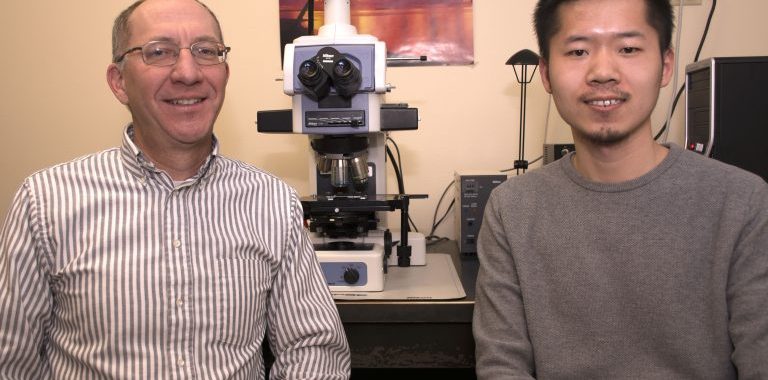
Wyoming’s serene plains and majestic mountains belie what’s going on under foot – organisms hunting, killing and generally wreaking havoc among the billions that make their living there.
In some cases, one-celled family members band together for protection and even unite to become true multicellular organisms in order to survive. How they recognize family members and coordinate activities has vexed scientists.
Molecular biologist Daniel Wall and Ph.D. student Pengbo Cao believe they’ve solved a piece of the mystery and show their results in an article published online last spring in the Proceedings of the National Academy of Sciences (PNAS).
“Self-identity reprogrammed by a single residue switch in a cell surface receptor of a social bacterium” describes a lone amino acid switch they found that can govern how the soil bacterium Myxococcus xanthus recognize their kin. The article is at http://bit.ly/pnaswall.
Social Butterflies
Microbes have a bad rap for being socially inept, but actually many of them live quite social lives. They identify close relatives then cooperate with them.
“If they really want to thrive, they need to come together, recognize each other and assemble into multicellular structures to form something that’s beyond the ability of the individual,” says Cao. “I was pretty amazed how such a small, single-cell microbe could exhibit such sophisticated social behaviors.”
M. xanthus cells move on solid surfaces and forage for food. Sensing when the food supply is about to run out, hundreds of thousands aggregate and form what are called multicellular fruiting bodies, which harbor spores highly resistant to environmental stress. They preserve the DNA information and regenerate when conditions are ideal again.
Wall notes that M. xanthus social behaviors can be compared to those other animals – swarms of insects, schools of fish, flocks of birds, herds of animals, all of which coordinate their movements with kin.
During development, these animals start as a single cell, a fertilized egg, and clonally divide to become a multicellular organism. But M. xanthus provides a developmental contrast. At the single cell level, he says, they form social groups that can further assemble to create multicellular organisms with coordinated activities and undergo cellular differentiation.
“They are a true multicellular organism, but they built it by an aggregation strategy,” says Wall.
Metropolitan Underground
Myxobacteria recognize other individuals that are genetically identical or related all while living in a very cosmopolitan environment, notes Wall. Soil, for example, can contain tens of thousands of different species and thousands more subspecies. Wall and Cao wanted to see how family members are recognized.
Efforts built on an earlier discovery by Wall and colleagues who found a particular cell receptor called TraA facilitated recognition among M. xanthus cells and allowed them to come together and exchange proteins and other components, a process called outer membrane exchange.
Cao notes different strains have different TraA sequences.
“The TraA receptors ensure when cells come in contact, the sharing of cellular resources only occurs with close relatives that have identical or very similar TraA receptors,” says Cao.
Wall and Cao asked if different TraA receptors allow cells to selectively bind one another..
So, they put different receptors labeled with different color markers into the same parent strain and showed that cells with different receptors formed distinct kin groups.
They then questioned how one receptor could create such diversity in recognition among natural populations so, using molecular scalpels and wrenches, they assembled parts of different TraA receptors and tested if cell recognition could be reprogrammed.
“Cao took the simplest case of two receptors very similar in sequence that only had 11 amino acid differences yet did not recognize each other,” says Wall.
Cao made a series of chimeras, using half of one receptor and half of another, and observed what the bacteria recognized.
They found a single amino acid within the receptor plays an important role in the recognition.
“This was a surprising result,” says Wall. “That changing one amino acid had such a dramatic impact on specificity.”
By changing this residue they even engineered a TraA receptor with unique specificity that only recognized itself.
Avoid Unpleasant Relatives
They hypothesize the malleability of TraA has allowed it to evolve and create social barriers between myxobacterial populations which, in turn, avoids nasty interactions with exploitive relatives.
Recognition is an important process because misrecognition of a neighboring cell could be lethal. Hundreds of different proteins are transferred during outer membrane exchange. Included in the mix are toxins and, if the other cell is not a true clonemate or self, they won’t have the antidote and will die (see related story). Wall and Cao speculate such adverse interactions may drive and maintain diversification of TraA sequences in nature.
M. xanthus’ predatory nature has drawn agricultural interest.
“They kill and consume other bacteria,” says Wall. “That’s how they make their living, by eating their microbial neighbors.”
Scientists want to use that predatory behavior for biocontrol.
“Myxobacteria themselves do not harm plants, but they can kill pathogens of crops,” says Wall. “M. xanthus, along with other types of microbes, are organisms of interest to use as a natural way to control and protect crops from disease.”





